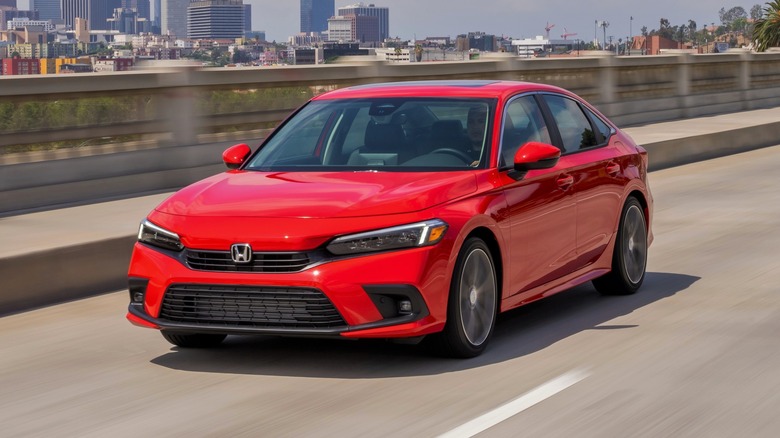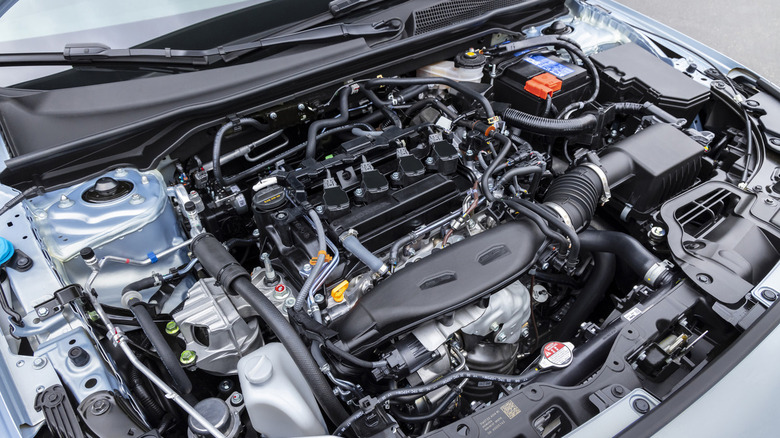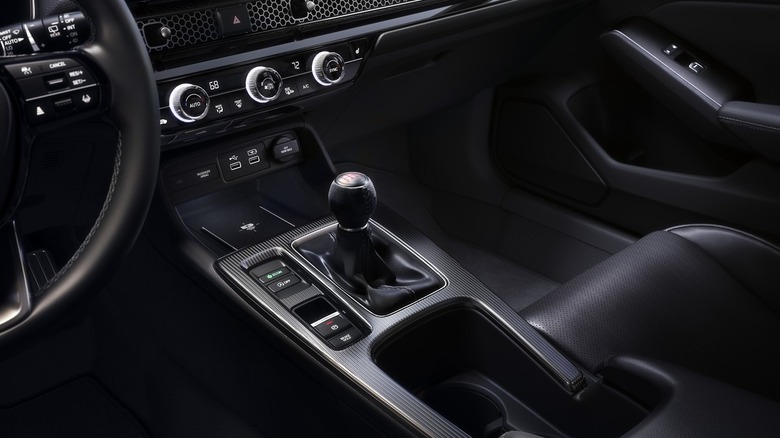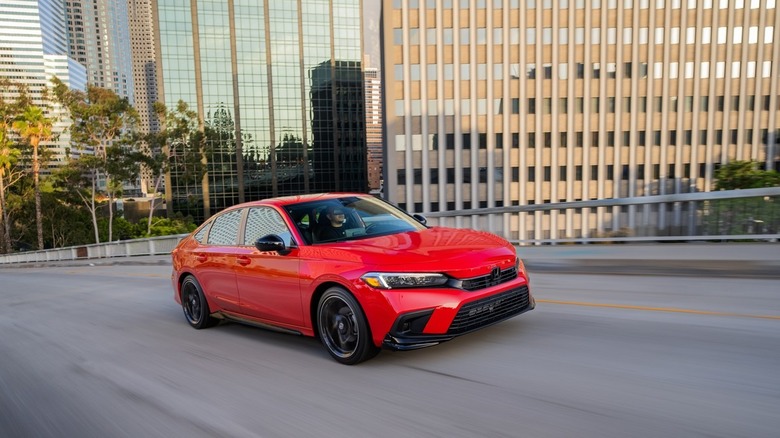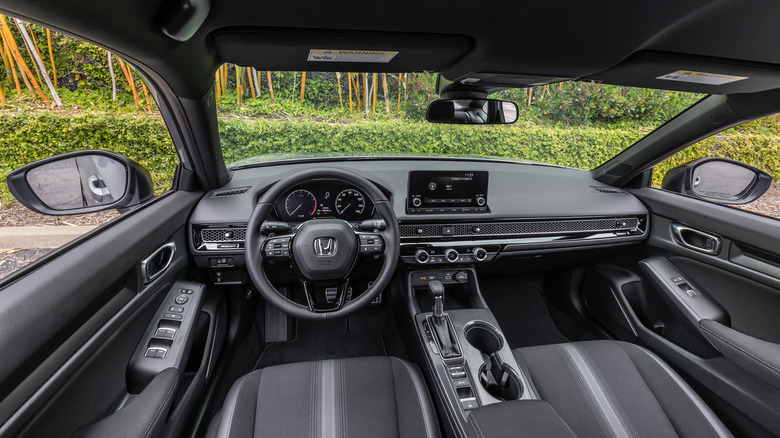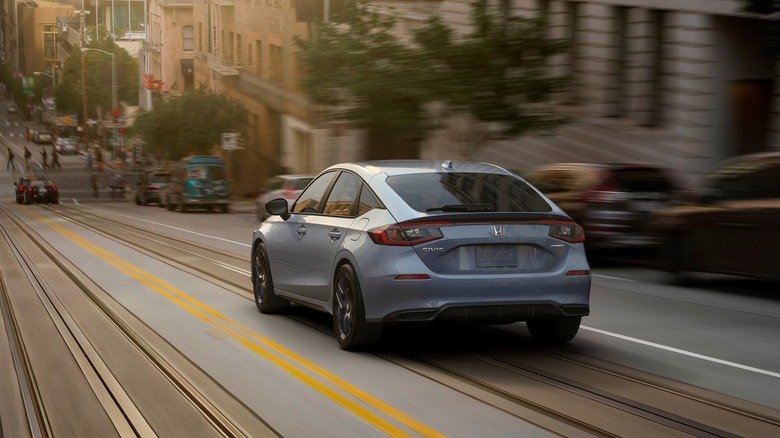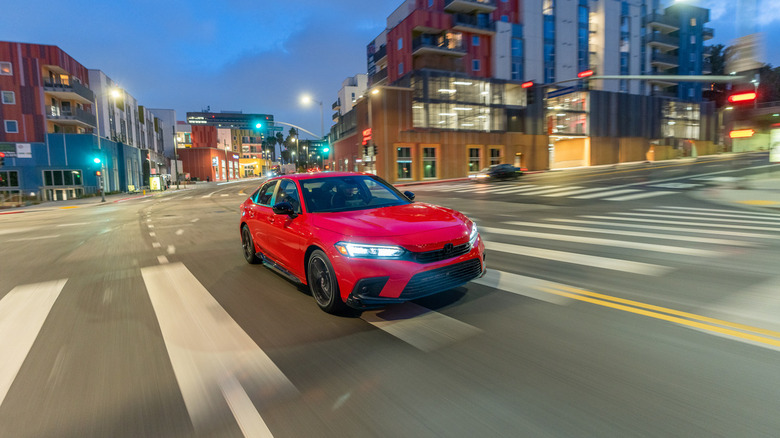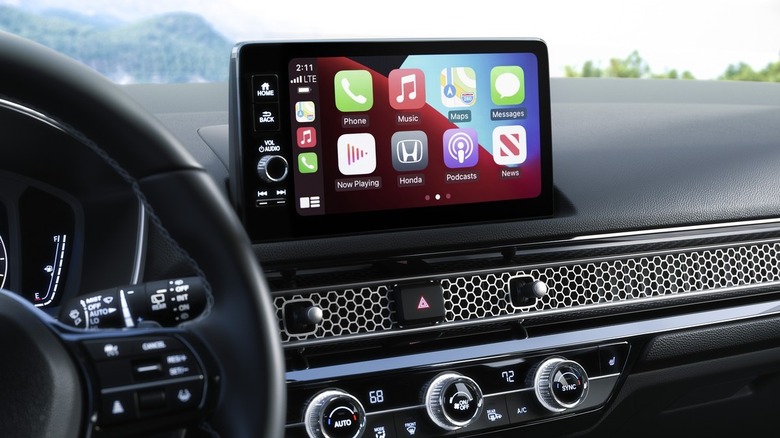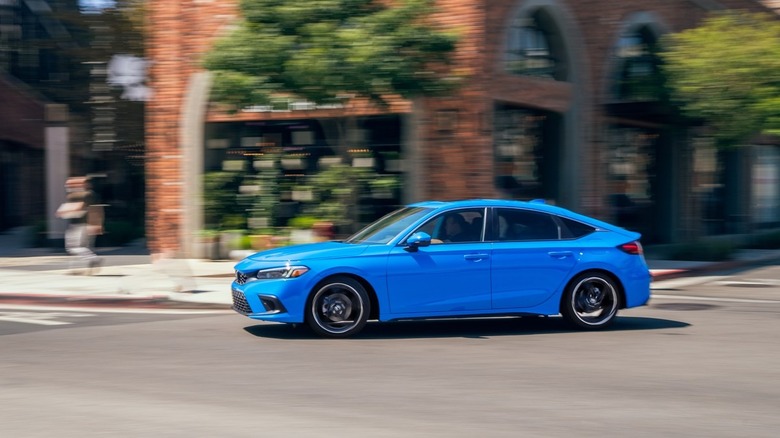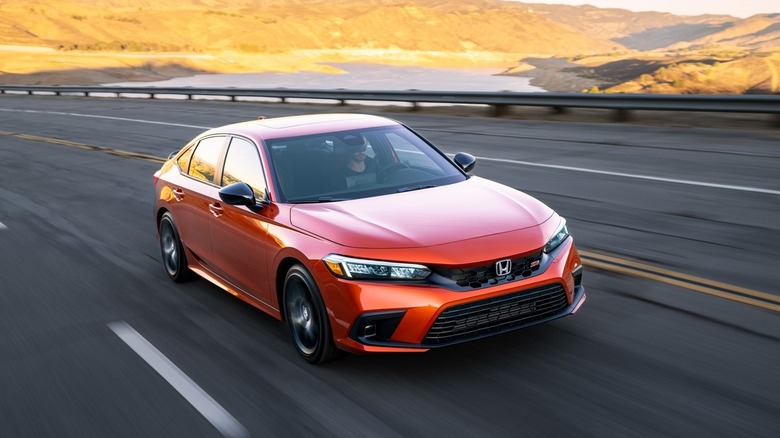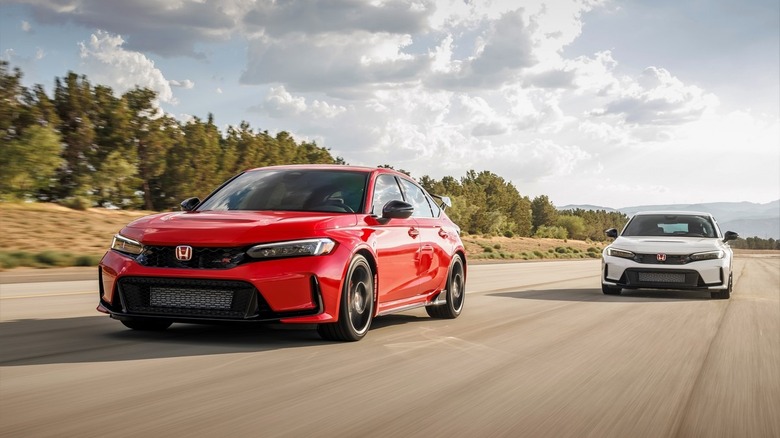The 10 Coolest Features Of The 2023 Honda Civic
The Honda Civic was unveiled in 1972 amid a challenging time for the then-fledgling carmaker. Its predecessor, the H1300, was selling very poorly, and Honda's executives realized they only had one more chance to design something that would bring in the revenue the firm so badly needed. A design was drawn up for a car that would be quick, light, and compact, aiming to be a good all-rounder that would appeal to both domestic and international markets. It was called the Civic, Honda says, to reflect its intended use "for citizens and [in] cities."
As it turned out, the car would become a huge success, proving to be a sales hit both domestically in Japan and in key export markets like the United States. The Civic has been in constant production ever since and is now in its eleventh generation, which debuted for the 2022 model year. Since Honda only gave the car a full overhaul last year, not much has changed for the 2023 model. That's no bad thing though, as the current car is packed full of innovative features that make it a strong contender for best in segment.
Turbocharged four-cylinder engine
The 11th-generation Civic is offered in a choice of two body styles, either in sedan form or as a hatchback. Both styles share the same engine options, with the standard option being a 2.0L four-cylinder making 158 horsepower, and there's a turbocharged 1.5L four-cylinder also available. The latter makes 180 horsepower, despite its smaller displacement, and it's arguably the better option. Our review of the 2022 model year car found that the turbo 1.5L felt like the bigger engine of the two, being more refined at cruising speeds, and more eager when a boost of acceleration was needed.
At some points in the rev range, there was also a slight lag in power in the 2.0L, whereas the 1.5L felt more consistent across both higher and lower revs. Neither engine feels truly sporty, but they're athletic enough to make everyday driving a bit more fun than Honda's main rivals.
Six-speed manual available on the hatchback
The manual transmission is a dying breed, at least in America, where stick shifts make up just 4% of cars on the roads. Many carmakers now choose to forgo them altogether, which is why it's good to see that Honda is sticking to its guns in offering a choice of either manual or automatic on its hatchback models. Sedans, however, only get auto boxes, for some reason. It seems a bit odd that the company has only chosen to include a manual option on one out of two body styles, but hey, it's worth celebrating the fact they still offer one at all.
Honda describes its manual shifter in its press release as having "short throws and a solid feel," giving "enthusiast drivers an even more engaging driving experience" than with the CVT. Unfortunately, SlashGear hasn't had the chance to drive the manual car yet to see for ourselves, so we'll have to take Honda's word for it.
Athletic exterior styling
The latest generation of the Civic debuted with all-new styling, and to put it simply: it looks great. Honda has managed to design a car that's sleek and athletic but doesn't look like it's trying too hard to be something it's not. The hood is lower than the previous-gen car, and the A-pillars have been pulled back to create a sportier look than before. There's also an all-new front end with a honeycomb grille and redesigned headlights.
Move around to the back of the car and you'll find a new integrated rear spoiler, as well as a rear track that's been widened by half an inch without affecting the overall width of the car. This supposedly contributes to steering stability, but it also gives the car a slightly more athletic look, which is accented by the new, wider exhaust tips. Make no mistake, this is still a budget Honda, but with its new exterior styling, the Civic looks a little more upmarket than its asking price would suggest, especially with the optional 18-inch alloy wheels.
Sleek, ergonomic interior
Alongside the revamped exterior, Honda also gave the cabin a complete makeover for the launch of the 11th-generation car. The interior was designed with a focus on simplicity, with the goal of making the controls and layout as intuitive to use as possible. Our review confirmed that this goal was very much achieved, with the plastic switches and buttons feeling solid and sturdy, and the air vent controls that jut out from the central honeycomb panel being equally pleasing to use.
There's a new seat technology at work here too, with Honda developing what it calls the Body Stabilizing Seat to enhance comfort on longer journeys. These seats are available for the driver and front passenger on all trims, and they work to stabilize the hips to reduce movement within the chair while driving. The bottom of the seat is also designed to prevent occupants from sliding forwards, which the brand says can contribute to fatigue and discomfort on long drives. There's also plenty of space behind the seats for luggage. The sedan's trunk offers 14.8 cubic feet of luggage, or 14.4 cubic feet on the Touring trim. That's enough to accommodate four standard-size golf bags, says Honda, with even more room available for longer items when the split rear seats are folded down.
Fuel-sipping economy
While it won't generate as many headlines as an unbelievable 0-60 mph time or a sleek new exterior design, a car's efficiency is arguably one of the most important factors to consider in today's new car market. Especially with the current climate of rising gas prices, it pays to have a car that sips as little fuel as possible, and the Civic is one of the best in its class. According to the Environmental Protection Agency, the most efficient Civic variant is the CVT-equipped 1.5L turbo, which gets 42 mpg highway and 33 mpg city. The base-spec 2.0L automatic also impresses, with 37 mpg highway and 30 mpg city, while the manual 1.5L turbo is the least efficient of the bunch, achieving 37 mpg highway and 27 mpg city.
Car and Driver conducted real-world testing and found that the Civic delivered roughly the same efficiency as its EPA figures, achieving 36 mpg over a 75 mph highway route, a fraction less than their Civic Sport's claimed 37 mpg. In real terms, this efficiency will likely translate into a significant saving at the gas pump over time compared to many of Honda's competitors.
Honda Sensing driver assistance
Honda's Sensing suite of driver assistance features has become bigger and better for the 11th-generation car, with a range of new systems added to keep drivers safe on the road. Traffic Jam Assist has been added to models equipped with a CVT transmission, and there's a new Traffic Sign Recognition feature that allows the car to intelligently feed information about speed limits and road conditions back to the driver. The car's adaptive cruise control has also been updated, and lane-keeping assist has been revised for smoother, less intrusive operation.
The whole Sensing system centers around a new single-camera-based system, which Honda says is faster than the old dual-setup of a camera and a radar. Alongside all the intelligent safety systems, the Japanese automaker has made sure to include a comprehensive suite of more traditional safety measures. In particular, new airbags are designed to reduce head rotation in the event of a collision, with Honda calling the technology a "world first." Standard knee airbags and rear seat side impact airbags are also available on all trims.
Optional 9.0-inch infotainment screen and Bose stereo
In another first for the Civic, the latest-generation car now features the first optional branded audio system for higher trims. Buyers of the top-spec Sport Touring hatchback can take advantage of a Bose premium sound system, with 12 speakers placed strategically throughout the cabin to ensure optimal sound quality for all passengers. This includes four neodymium tweeters, two embedded into the A-pillars and two in the rear doors, and a Bose Twiddler mid/high-range speaker in each C-pillar. There's also an 8-inch woofer mounted in the rear quarter panel, a high-range speaker in the center of the instrument panel, and four more wide-range speakers, one in each door.
Honda says it worked with Bose's engineers to ensure that sound remains crystal clear at all speeds, introducing what it calls Dynamic Speed Compensation to automatically adjust the tone and volume of music based on the speed of the vehicle. The sound system can be controlled through the Civic's optional 9.0-inch infotainment screen, with a 7-inch touchscreen available on lower trims. Every trim includes Android Auto and Apple CarPlay compatibility, and Sport Touring buyers also benefit from wireless smartphone charging as standard.
Competitive pricing
While the 2023 Civic might not be the absolute cheapest car in its class, it's arguably one of the best in terms of value for money. The cheapest trim for 2023 is the Sport sedan, which starts at $25,745 including fees. The Sport hatchback costs a little more at $26,545, with the mid-range EX sedan and hatchback costing $27,145 and $28,845, respectively. The Touring sedan breaks the $30,000 mark, coming in at $30,745 including fees, and the range-topping Sport Touring hatchback will set buyers back $31,645.
There are several rivals that offer cheaper starting prices, with the Volkswagen Jetta, Hyundai Elantra, and Nissan Sentra all costing less in base-spec form than the Honda. However, none of those cars feel as good to drive, and their standard equipment list is a lot less generous. We'd even argue that the Civic is the sharpest-looking of them all too, especially since it was totally overhauled just last year. Another factor to keep in mind when evaluating value for money is resale price, and that's where the Civic really shines. According to data from CarEdge, the average Honda Civic will depreciate just 16% in five years, making it one of the best mass-produced cars on the road in terms of holding its value. Not to mention, Civics are generally so reliable that drivers shouldn't have to ever worry about spending a lot on maintenance.
Sporty sensibility with the Si
If the "regular" Sport Touring still isn't quite sporty enough, Honda offers the Civic Si, a sort of halfway house between the standard range and the full-fat Civic Type R. It offers stiffer suspension and revised steering for a better feel, paired with an upgraded version of the 1.5L turbo that now makes 200 horsepower, a 20 horsepower boost over the Sport Touring. There are also a few unique bits of exterior trim, but nothing particularly flashy. It might even be hard to tell a Si from a regular Civic from a distance, but that's deliberate. This isn't a car for drivers that want to shout about their vehicle's performance, but rather, ones that enjoy making the most of everyday driving.
SlashGear reviewed the 2022 model and found that it was indeed great fun at road legal speeds, but even when pushed beyond that, it still remained eager to go. Peak horsepower doesn't kick in until 6,000 rpm, meaning the Si can pull hard right up to its redline of 6,500 rpm. Its chassis was also very communicative on California's winding backroads, whether at adrenaline-inducing speeds or just cruising. On top of that, the Si retains all the same standard tech and convenience features from the standard top-spec Civic.
Track-ready performance with the 2023 Type R
For drivers looking for the ultimate version of the Civic, Honda's crown jewel of the range is the Type R. It boasts 315 horses under the hood, a stick shift as standard, and a whole bunch of aero bits to let passersby know that this is no regular Civic. However, with a starting price of $42,895, it's a serious investment, and a huge premium over even the Si model. Honda says the new Type R is the most powerful production model the brand has ever offered in the United States, although it's worth noting that statement is not true for other territories, where the NSX is sold under the Honda name.
It's also the most expensive Honda currently on offer, even surpassing the Passport SUV's starting price. Mamadou Diallo, vice president of sales at American Honda, claimed in the car's press release that it is "the sportiest, most fun-to-drive Civic in our history," which seems to be setting the bar very high, indeed. We haven't had a chance to test out the new Type R yet, but we'll be waiting with bated breath to see if it's as good as Honda says it is.
